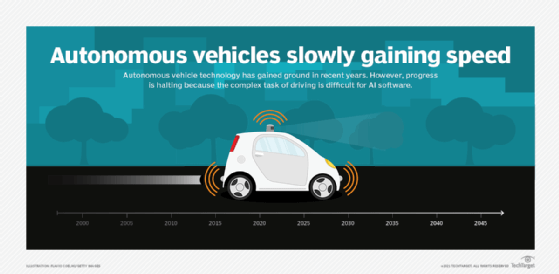
Getty Images/iStockphoto
The rise of robotaxis
Robotaxis use sensors and AI to navigate without drivers. Despite operating in many cities, they face safety, regulatory and trust issues while promising to change transportation.
Robotaxis are self-driving vehicles designed to operate without a human cab driver for a ridesharing company. These fully autonomous vehicles employ several types of sensors and artificial intelligence (AI) to collect data about their surroundings, enabling safe navigation to a set destination.
Robotaxis have already disrupted the public transportation industry. They may transform it, promising increased use of public transport, reduced reliance on private vehicles, lower operating costs for invested businesses and cheaper fares for users, as well as improved traffic flow and road safety.
Currently, companies in the U.S., China and the EU are developing and testing robotaxis. They operate in several cities, yet numerous challenges impede their widespread adoption – on-road safety hurdles, regulatory compliance, cyberthreats and lack of public trust.
The technologies that make robotaxis go
Robotaxis and other self-driving cars combine disparate advanced technologies during operation. These include:
- AI and machine learning. AI processes data from the vehicle's sensors to make real-time driving decisions, while machine learning improves the vehicle's performance and decision-making abilities over time.
- Cameras and computer vision. Multiple cameras around the vehicle improve its machine vision, enhancing object recognition and environmental detail.
- LiDAR. LiDAR, or light detection and ranging, determines distances by emitting a laser beam at surrounding targets and measuring the time the beam takes to return. It also creates 3-D maps of its surroundings to detect nearby objects.
- Radar. Radar also detects nearby objects and provides accurate distance measurements.
- GPS. The Global Positioning System determines the vehicle's geographical location and enables the vehicle to map and navigate its route.
Robotaxis typically include all the above, plus any redundant safety systems to prevent accidents. These onboard sensors measure vast amounts of data to determine the vehicle's surroundings.

That data is then fed through image recognition systems, neural networks and machine learning systems. Neural networks search for patterns in the data to identify surrounding objects —pedestrians, traffic lights, curbs, trees and street signs -- while the robotaxi is moving.
As an example, data from a camera feeds through an image recognition system to determine nearby object outlines, shapes and details. That information is then cross-referenced with the LiDAR and radar data to confirm distance, depth and movement. The LiDAR data also creates an accurate 3-D map of the vehicle's surrounding environment on demand.
The robotaxi must first build a map of its environment to understand its surroundings. From there, it plans a path to its destination. AI and GPS determine the safest and fastest route while following traffic rules and avoiding obstacles.
Most robotaxis also use geofencing, which forces the vehicle to navigate within predefined boundaries. These areas are typically mapped in detail, ensuring the robotaxi operates effectively and consistently. Override functions enable a human to take control of the vehicle if needed.
Tesla, a newer competitor in the robotaxi space, champions self-driving features using cameras without LiDAR. While possible, camera-only systems struggle to determine depth and distance accurately. They also perform poorly in low light and adverse weather. Current camera-only systems struggle to determine the difference between the taillights of a nearby motorcycle and a distant car, a further burden on motorcyclists. Combining LiDAR and camera systems improves passenger and bystander safety. It also maintains the consistency of operation regardless of weather or environment.
The rise of robotaxis
NuTonomy, an MIT spinoff and startup, introduced robotaxis to the public in 2016. The organization launched a set of modified electric vehicles in a limited area of Singapore, using Mitsubishi i-MiEVs and Renault Zoes. That same year, General Motors (GM) acquired Cruise Automation, another self-driving startup. In 2017, Cruise Automation began a beta version for a robotaxi service in San Francisco using a fleet of Chevrolet Bolt electric vehicles.
Several companies, following those above, began testing autonomous driving and robotaxi services, including:
- In 2016, Uber offered robotaxi service to a small group of users in Pennsylvania.
- In 2017, Waymo, a new leader in the space, began testing robotaxis in geo-fenced areas of Arizona.
- The next year, Waymo tested a paid robotaxi service while using safety drivers, and in 2020, the company began offering fully driverless service.
- Also in 2018, Yandex began trialing self-driving vehicles in Russia.
- In 2019, Baidu began a robotaxi trial called Apollo Go in China.
- Also in 2019, Pony.ai began robotaxi testing in China and California.
Advances in AI and LiDAR, along with better mapping technologies, spurred this growth.
In 2025, robotaxi and autonomous car testing continues globally, with China leading in commercial deployments. Waymo, Cruise, Apollo Go, Amazon's Zoox and other robotaxi services have already accumulated tens of millions of miles on the road, according to an IDTechEx report. The same report expects the robotaxi vehicle market value to grow through 2045.
Despite advancement opportunities throughout the self-driving space, robotaxis must overcome major hurdles before acceptance.
The challenges robotaxis face
On a night in 2018, a woman attempted to cross a street in Arizona when she was struck and killed by a self-driving Uber vehicle. The safety driver involved was not paying attention. It was dark, increasing the challenges involved for the vehicle, and the onboard technology failed to identify the woman as a pedestrian. Because of this, it failed to apply its brakes.
Although technology has improved since this accident, it underscores the catastrophic nature of a technological mistake, the need for a range of sensor types and the importance of redundant safety systems should sensors fail.
A Zoox robotaxi collided with a passenger vehicle in Las Vegas on April 8, 2025, prompting the company to stop service and issue a software recall on 270 of its autonomous vehicles. There were no injuries and minor damage to both vehicles. In a May 1 report to the National Highway Traffic Safety Administration, the company cited a defect in its autonomous driving system that increased the risk of a crash. Zoox resumed services following a software update to its entire fleet.
Safety remains a concern for many consumers, and understandably so. Autonomous systems must handle all possible driving conditions, adapting to unpredictable human driving behavior and identifying pedestrians, different kinds of vehicles and their distances. Cybersecurity is another safety issue. Developers must employ extensive security measures to protect vehicles from hackers or other cyberattacks.
Today, there are several documented incidents of robotaxis causing traffic issues: They drive in circles, block lanes or, confused in complex environments, stop unexpectedly. Autonomous cars wait in search of a safe response, which creates traffic congestion. Driverless vehicles also face varying regulations depending on where they operate. Some governments require more stringent safety tests before approving robotaxi operation.
Cost is another challenge. The development and deployment of these technologies, such as LiDAR, is expensive.
Some companies tried to develop robotaxis but canceled their plans. Apple reportedly began construction on a self-driving vehicle, but the project was dropped in 2024. GM shut down Cruise, absorbing it into different technical teams at the company. Uber also shuttered its autonomous vehicle division in 2020.
What's next?
China leads in robotaxi distribution; commercial deployments and testing occur in multiple cities today. In the U.S., robotaxi deployments are available in specific areas of different cities. For example, Waymo currently operates in Phoenix, San Francisco, Los Angeles and Austin, Texas, with plans to expand to Atlanta and Miami.
Australia, Germany, Japan, Switzerland and Turkey aim to launch robotaxis in some form as well. Meanwhile, tests for autonomous vehicles are underway in France, New Zealand, Norway, Singapore, South Korea and Sweden.
The AI systems used in autonomous driving settings must be explainable and trustworthy. Learn more about what goes into making an AI system with common sense.






